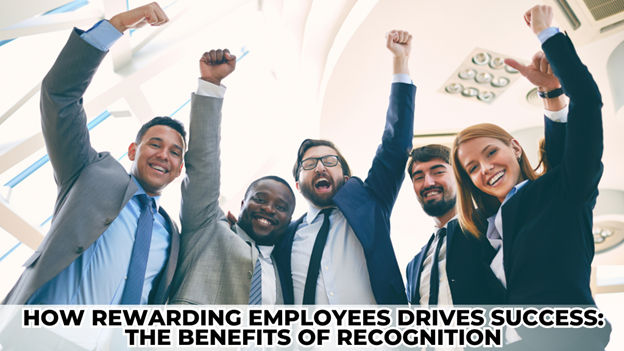How Rewarding Employees Drives Success: The Benefits of Recognition
Did you know that companies with strong employee recognition programs see higher productivity? Think about the last time someone praised your work—it likely made your entire day better! Now imagine feeling that way regularly at your job. Companies that master the art of employee recognition don’t just make their workers happier—they build powerhouse teams that drive amazing results.
Surprisingly, 65% of employees haven’t received any form of recognition in the last year. This simple oversight costs businesses billions in lost productivity and high turnover rates. With the right approach to recognition, companies can transform their workplace culture and boost their bottom line.
Modern Recognition Solutions
Today’s workforce expects more than the traditional “Employee of the Month” plaque. Companies increasingly turn to digital solutions that make recognition immediate and meaningful. A well-designed employee rewards and recognition platform helps organizations create a culture of appreciation and continuous feedback.
Digital recognition tools transform how teams celebrate success and share achievements. These platforms enable peer-to-peer recognition alongside manager feedback. Regular recognition through these systems builds stronger team connections and improves workplace morale.
Impact on Business Performance
| Aspect | Without Recognition | With Recognition |
| Turnover Rate | 45% higher | Industry average |
| Productivity | Standard | 27% higher |
| Innovation | Limited | Significantly higher |
| Employee Satisfaction | Below average | Above average |
Companies investing in recognition programs see measurable improvements in key performance indicators. Teams with strong recognition cultures report higher engagement levels and better customer service scores. These improvements directly impact company growth and profitability.
Recognition programs create a positive feedback loop in organizational performance. Employees who feel valued bring more energy and creativity to their work. This enhanced performance leads to better business outcomes and increased opportunities for recognition.
Key Benefits of Recognition Programs
- Regular recognition increases employee engagement and job satisfaction, leading to higher retention rates and reduced hiring costs
- Strong recognition cultures foster innovation and creativity by encouraging employees to share ideas and take calculated risks
- Well-designed recognition programs improve team collaboration and communication across all organizational levels
Building Effective Programs
Successful recognition programs require clear goals and consistent implementation. Programs should align with company values and strategic objectives. Regular review and adjustment ensure the program continues meeting organizational needs.
Employee input shapes effective recognition programs. Workers know what types of recognition feel most meaningful to them. Including their perspectives helps create programs that truly motivate and inspire.
Recognition Tools and Technology
Modern apps and software make it super easy to give kudos to coworkers. These digital tools let everyone send quick thank-you messages and virtual high-fives. Teams can celebrate wins together even when working from different places.
Company leaders track how recognition improves team spirit through these platforms. The software shows which teams give the most recognition to each other. Digital rewards systems help managers spot top performers and rising stars.
Creating Fun Recognition Events
Company parties and celebrations bring teams together to honor great work. Fun events like award ceremonies make recognition more exciting and memorable. Teams bond better when they celebrate successes together.
Monthly or quarterly events keep the recognition momentum going all year. Special themes and creative awards make these gatherings more engaging. Employee feedback helps shape events that everyone looks forward to attending.
Budget-Friendly Recognition Ideas
Small gestures often mean just as much as big rewards. Hand-written thank you notes and public praise cost nothing but mean everything. Creative recognition doesn’t need a big budget to make a big impact.
Teams can start recognition programs with simple appreciation boards or team meetings. Managers can give extra break time or pick choice assignments as rewards. These zero-cost options still make employees feel valued and appreciated.
Training Managers in Recognition
Good managers learn how to give meaningful recognition to their teams. They understand timing matters just as much as the recognition itself. Training helps leaders spot opportunities to praise good work.
Regular workshops teach managers new ways to recognize different personalities. They learn how to match recognition styles to individual preferences. Good training ensures recognition feels sincere and personal.
Measuring Recognition Success
Companies carefully track how recognition programs influence employee happiness since data consistently shows that satisfied employees remain in their positions longer. Regular surveys provide valuable insights into the effectiveness of recognition efforts. Monthly reports highlight which departments excel at giving recognition.
Leaders gain clear visibility into how recognition connects to improved work outcomes across the organization. Regular data analysis helps teams refine and enhance their recognition programs over time. This systematic approach ensures recognition initiatives deliver meaningful results.
Remote Worker Recognition
Distributed teams require special attention to maintain their connection to the organization. Virtual recognition serves as a vital bridge across physical distances between team members. Online celebrations help remote employees feel fully integrated into the team culture.
Personal video calls make recognition more meaningful for remote staff members. Digital badges and rewards provide an immediate appreciation for remote workers’ contributions. When leaders make the extra effort to recognize remote employees, it reinforces their essential value to the organization.
Peer-to-Peer Recognition
While managers play an important role, coworkers are often the first to notice exceptional work. This peer-level recognition naturally builds stronger workplace relationships and enhances team collaboration. Daily interactions provide numerous opportunities for colleagues to acknowledge each other’s contributions.
Team members are uniquely positioned to understand both the challenges and achievements of their peers. Through consistent peer recognition, a more supportive and collaborative work environment emerges. This creates a positive feedback loop that strengthens team bonds and improves overall performance.
Cultural Sensitivity in Recognition
Recognition preferences vary significantly across cultures, requiring companies to thoughtfully adapt their approach. Understanding these cultural differences helps organizations ensure their recognition feels authentic and meaningful. Smart companies actively adjust their recognition styles to accommodate diverse cultural preferences.
Global teams particularly benefit from flexible recognition approaches that respect cultural nuances. Some team members may prefer quiet acknowledgment while others thrive on public celebration. Taking these cultural differences into account helps strengthen international team bonds and creates a more inclusive workplace.
Recognition for Different Generations
Each generation brings unique preferences to the workplace, from Baby Boomers to Gen Z. Younger employees often gravitate toward instant feedback and digital recognition platforms. Their older colleagues might appreciate more traditional forms of acknowledgment.
Forward-thinking companies address these differences by implementing diverse recognition programs. This variety reaches all age groups effectively while creating opportunities for cross-generational learning. Different generations can share and learn new ways of giving recognition to each other.
Long-Term Recognition Strategy
Successful recognition programs must evolve alongside growing organizations. Developing flexible strategies ensures recognition remains impactful as company objectives change. Regular program assessment maintains employee engagement and relevance.
Team feedback drives continuous improvement in recognition methods and approaches. Organizations use this input to refine their recognition programs year after year. This strategic approach to recognition creates a lasting positive impact throughout the organization.
Conclusion
Creating a culture of recognition takes commitment and consistency. The investment pays off through improved performance, higher retention, and stronger team dynamics. Every organization can benefit from thoughtful employee recognition.
Start building your recognition program by gathering employee feedback on what matters most to them. Remember that effective recognition happens regularly and ties directly to organizational values and goals. Your investment in employee recognition will drive success across your entire organization.
Frequently Asked Questions
How often should employees receive recognition?
Regular recognition works best, with weekly or bi-weekly acknowledgment of contributions and achievements.
What types of recognition have the biggest impact?
Immediate, specific recognition tied to company values and goals proves most effective in motivating employees.
How can small businesses implement recognition programs?
Even simple, low-cost recognition efforts can make a big difference when consistently applied.




